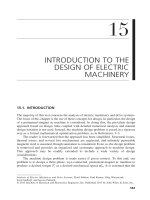TROUBLESHOOTING GUIDE OF ELECTRIC FORKLIFT TRUCK: 88 PALLET TRUCKS 8HBW30 36,001 AND UP 8HBE30 36,001 AND UP 8HBE40 36,001 AND UP 8HBC30 36,001 AND UP 8HBC40 36,001 AND UP 8TB50 36,001 AND UP SERVICE MANUAL 00700-CL398-07 ĐIỂM CAO
Bạn đang xem bản rút gọn của tài liệu. Xem và tải ngay bản đầy đủ của tài liệu tại đây (1.98 MB, 46 trang )
<span class="text_page_counter">Trang 1</span><div class="page_container" data-page="1">
<b>Pallet Trucks</b>
<b>SERVICE MANUAL</b>
</div><span class="text_page_counter">Trang 2</span><div class="page_container" data-page="2"><b>Table of Contents</b>
<b>How To Use This Manual . . . 1-1</b>
Map of the Manual . . . 1-2 Initial 90 Day/250 Deadman Hours (HD) Maintenance . . . 4-3 Every 180 Days or 500 Deadman Hours . . . 4-4 Every 360 Days or 2000 Deadman Hours (HD) . . . 4-6 Grease Fittings . . . 4-7
<b>Troubleshooting . . . 5-1</b>
How to Use This Section . . . 5-2 Electrical Troubleshooting Guidelines . . . 5-3 DC Electric Motor Tests . . . 5-7 AC Electric Motor Tests . . . 5-9 Hydraulic Troubleshooting Guidelines . . . 5-10 Definitions . . . 5-11 List of Electrical Symbols . . . 5-15 Operator Display and Programming . . . 5-17 Service Input/Output Displays . . . 5-23 Traction Power Amplifier LED Diagnostics . . . 5-26 Traction Power Amplifier Flash Codes . . . 5-27 Troubleshooting Flowcharts . . . 5-29 Caution and Error Codes . . . 5-33 Symptom Tables: Lift/Lower System . . . 5-55 Symptom Tables: Travel (Forward/Reverse) System . . . 5-59 Symptom Tables: Wiring System . . . 5-68 Pinout Matrix . . . 5-69
<b>Component Procedures . . . 6-1</b>
List of Component Procedures . . . 6-2 Component Locator Photos . . . 6-5 Tractor Cover . . . 6-7
</div><span class="text_page_counter">Trang 3</span><div class="page_container" data-page="3">Traction Power Amplifier . . . 6-25 AMP Harness/Traction Power Amplifier Connector . . . 6-27 Pallet Entry Sliders . . . 6-72 Fork Height Adjustment . . . 6-73
Lubrication Equivalency Chart . . . A-2 Torque Chart - Standard (Ferrous) . . . A-3 Torque Chart - Standard (Brass) . . . A-4 Torque Chart - Metric . . . A-5 Torque Chart - Thread-Forming Screws . . . A-6 Decimal Equivalent Chart . . . A-7 Standard/Metric Conversions . . . A-9 Electrical Schematics . . . B-1
<b>Index . . . I-1</b>
</div><span class="text_page_counter">Trang 4</span><div class="page_container" data-page="4"><b>Section 1. How To Use This Manual</b>
</div><span class="text_page_counter">Trang 5</span><div class="page_container" data-page="5"><b>Map of the Manual</b>
<small>How to Use This</small>
<small>Fault Codes &Caution & Error</small>
</div><span class="text_page_counter">Trang 6</span><div class="page_container" data-page="6">Manual Design
<b>Manual Design</b>
<i>The Toyota Pallet Truck Service Manual is </i>
designed with the following objectives in mind: • Provide technical coverage for expected
levels of user expertise
• Anticipate your needs and reduce your decisions regarding maintenance • Reduce page flipping thru a “one-stop
shopping” approach
The two-line running page header at the top of each page tells you:
• <i>Name of the manual (Toyota Pallet Truck </i>
Service Manual) • Current section title
<i>(for example, this page How to Use This Manual)</i>
• Current topic
<i>(for example, this page Manual Design) </i>
We suggest you get in the habit of turning to the
<b>START page first when you use this manual.</b>
• <b>The START page asks a few questions to </b>
guide you to the correct section.
<b>How to Use This Manual explains the manual </b>
format and contains the START page.
<b>Safety explains warning and caution notes, </b>
general safety rules and safety rules for batteries, static, jacking, and welding.
<b>Systems Overview includes truck </b>
specifications and theory of operation information.
<b>Planned Maintenance outlines the </b>
recommended schedule of preventive services to keep your truck working most efficiently.
<b>Troubleshooting is a set of fault, caution, and </b>
error codes, charts and tables designed to take you from a symptom to a specific sequence of actions in order to isolate a failing component.
• <b>The chart “Traction Power Amplifier Flash Codes” on page 5-27 will guide you </b>
thru the flash codes displayed on the LED’s installed on the TA.
• <b>The section “Caution and Error Codes” </b>
on page 5-33 defines the various codes displayed on the operator display. • <b>The chart “TS1: START </b>
<b>TROUBLESHOOTING” on page 5-29 will </b>
guide you to the symptom chart you need. • When you’re familiar with the symptoms
listed, you may simply look up the
<b>symptom from the “Troubleshooting” on </b>
page 5-29.
• As you work with a troubleshooting chart, code, or table, you may be instructed to test various electrical connector pins. The pinout matrix chart lists information on functions and normal voltages of terminals
<b>and harness connector pins. See “Pinout Matrix” on page 5-69.</b>
• When you complete a troubleshooting procedure, perform the steps in the
<b>“END1: End of Troubleshooting Procedure” on page 5-31.</b>
<b>Component Procedures gives step-by-step </b>
procedures for testing, removal, installation, and adjustment of individual truck
components. Components are listed in an order that considers:
• Frequency of attention
• Physical attachment (for example, remove the brake before the traction motor) • Functional relation (for example, traction
motor and drive unit components are grouped together)
To find a component procedure, you may use one of three methods:
• <b>Look up the component name in the “List of Component Procedures” on page 6-2.</b>
• <b>Find the component in the “Component Locator Photos” on page 6-5.</b>
• Look up component name in the “Index”.
<b>Appendix contains reference information such </b>
as torque values, lubricants, and schematics.
<b>Index lists subjects alphabetically.</b>
</div><span class="text_page_counter">Trang 7</span><div class="page_container" data-page="7">Abbreviations & Symbols
<b>Abbreviations & Symbols</b>
These abbreviations, acronyms and symbols are used in this manual.
ANSI American National Standards Institute
BSOC Battery State-of-Charge
CAN Controller Area Network
EE UL Electric Truck Type Certification Rating where electrical equipment is completely enclosed
ESD Electrostatic Discharge
ETAC <i>Electronic Tiller Arm Control (See </i>
Vehicle Manager)
km/hr kilometers per hour
psi pounds per square inch PWM Pulse Width Modulation
RCFP Relay Control Fuse Panel
RPM Revolutions per Minute
</div><span class="text_page_counter">Trang 8</span><div class="page_container" data-page="8">Abbreviations & Symbols
VAC Volts Alternating Current
</div><span class="text_page_counter">Trang 11</span><div class="page_container" data-page="11"><b>Section 2. Safety</b>
</div><span class="text_page_counter">Trang 12</span><div class="page_container" data-page="12">In this manual, you will see two kinds of safety reminders:
<b>A warning specifies a potentially hazardous situation that, if not prevented, could result in death or serious injury.</b>
<b>A caution specifies a potentially </b>
<b>hazardous situation that, if not avoided, could result in minor or moderate injury or in damage to the lift truck or nearby objects. A caution can also alert against unsafe practices.</b>
</div><span class="text_page_counter">Trang 13</span><div class="page_container" data-page="13">General Safety
<b>General Safety</b>
<i>Do not operate or work on this truck unless you </i>
are trained, qualified and authorized to do so, and have read the Owner/Operator Manual.
Know the truck’s controls and what they do.
<i>Do not operate this truck if it needs repair or if </i>
it is in any way unsafe.
Operate this truck only from the operator’s position.
Before working on this truck, always turn the key switch to OFF and disconnect the truck’s battery connector (unless this manual tells you otherwise).
<i>Do not wear watches, rings, or jewelry when </i>
working on this truck.
</div><span class="text_page_counter">Trang 14</span><div class="page_container" data-page="14">General Safety
Obey the scheduled lubrication, maintenance, and inspection steps.
Obey exactly the safety and repair instructions
<i>in this manual. Do not take “shortcuts.”</i>
<i>Do not use an open flame near the truck.</i>
<i>Do not use gasoline or other flammable liquids </i>
for cleaning parts.
Clean up any hydraulic fluid, oil, or grease that has leaked or spilled on the floor.
Always park this truck indoors.
<i>Do not park this truck in a cold storage area </i>
</div><span class="text_page_counter">Trang 15</span><div class="page_container" data-page="15">General Safety
<i>Do not add to or modify this truck until you </i>
contact your local authorized Toyota dealer to receive written manufacturer approval.
<small>2</small>
</div><span class="text_page_counter">Trang 16</span><div class="page_container" data-page="16">Battery Safety
<b>Battery Safety</b>
<b>As a battery is being charged, an </b>
<b>explosive gas mixture forms within and around each cell. If the area is not correctly ventilated, this explosive gas can remain in or around the battery for several hours after charging. Ensure there are no open flames or sparks in the charging area. An open flame or spark can ignite this gas, resulting in serious damage or injury.</b>
<b>Battery electrolyte is a solution of sulfuric acid and water. Battery acid causes burns. If any electrolyte comes in contact with your clothing or skin, flush the area immediately with cold water. If the solution gets on your face or in your eyes, flush the area with cold water and get medical help immediately.</b>
Wear personal protective equipment to protect eyes, face and skin when checking, handling or filling batteries. This equipment includes goggles or face shield, rubber gloves (with or without arm shields) and a rubber apron.
Make sure a shower and eyewash station are nearby in case there is an accident.
<i>A battery gives off explosive gases. Never </i>
smoke, use an open flame, or use anything that gives off sparks near a battery.
Keep the charging area well-ventilated to avoid hydrogen gas concentration.
<small>204g6s058.eps</small>
</div><span class="text_page_counter">Trang 17</span><div class="page_container" data-page="17">Battery Safety
<i>Always turn the key switch to OFF before </i>
disconnecting the battery from the truck at the
<i>battery connector. Do not break live circuits at </i>
the battery terminals. A spark often occurs at the point where a live circuit is broken.
<i>Do not lay tools or metal objects on top of the </i>
battery. A short circuit or explosion could result.
Keep batteries clean. Corrosion causes shorts to the frame and possibly sparks.
Keep plugs, terminals, cables and receptacles in good condition to avoid shorts and sparks.
Keep filler plugs firmly in position at all times when not checking the electrolyte level, adding to the cells, or checking the specific gravity.
Make sure the vent holes in the filler plugs are open to let the gas escape from the cells.
<i>Do not permit cleaning solution, dirt or any </i>
foreign matter to enter the cells.
Make sure you install the correct size battery. A smaller or lighter weight battery could seriously affect truck stability. See the truck’s
specification plate for more information.
</div><span class="text_page_counter">Trang 18</span><div class="page_container" data-page="18">Battery Safety
<i>Never plug a battery charger into the truck’s </i>
battery connector. Plug the battery charger only into the battery connector from the battery.
Obey the charging procedures in the Battery Instruction Manual and in the Battery Charger Instruction Manual.
<small>225l6s014.eps</small>
</div><span class="text_page_counter">Trang 19</span><div class="page_container" data-page="19">Jacking Safety
<b>Jacking Safety</b>
You may need to jack the truck off the floor to perform maintenance procedures. When doing so, observe the correct safety precautions:
<b>Use extreme care whenever the truck is jacked up. Keep hands and feet clear from vehicle while jacking the truck. After the truck is jacked, put solid blocks </b>
<i><b>beneath it to hold it. Do not rely on the </b></i>
<b>jack alone to hold the truck.</b>
<b>Tractor Section</b>
1. Lower the forks completely. Remove any load.
2. Put all controls in neutral position. 3. Block the wheels to prevent movement of
the vehicle.
4. Disconnect the battery connector. 5. Put the jack in the designated jacking
6. Jack one side of the truck so that the drive tire is no more than 1 in. (25.4 mm) off the floor.
7. Block that side of the truck in position. 8. Jack the other side of the truck level with
the first side.
9. Block that side of the truck in position.
<b>N<small>OTE</small>: After working on a vehicle, test all </b>
controls and functions to make sure operation is correct.
<b>Fork Section</b>
1. Using the lift button, lift the forks to maximum height.
2. Block each fork by placing a block behind the load wheels. The tractor section will
</div><span class="text_page_counter">Trang 20</span><div class="page_container" data-page="20">Tie-Down for Transport
<b>Tie-Down for Transport</b>
To transport your Toyota pallet truck in an over-the-road vehicle or rail car, perform these steps:
1. Lower the forks and put the truck in the center of the transport vehicle.
2. Using suitable lifting device, remove the battery. See “Battery” on page 6-8. 3. Position the adjustable chain over and
thru the battery compartment.
4. Position an additional adjustable chain over and thru the battery compartment. 5. Position the chain ends of one chain
toward the front of the vehicle bed and the chain ends of the other chain to the back of the vehicle bed and draw taut. See Figure 2-1.
<b>N<small>OTE</small>: This will secure the truck to the vehicle </b>
bed and prevent tip-over and forward or backward movement.
6. Secure the battery according to the battery manufacturer’s instructions. If equipped, remove the battery cover or storage tray from the top of the battery and store separately.
<i>Figure 2-1.Tie-Down for Transport</i>
</div><span class="text_page_counter">Trang 21</span><div class="page_container" data-page="21">To safely tow a Toyota pallet truck:
1. Lower the forks and remove any load. 2. Turn the truck OFF and disconnect the
battery connector.
3. Using a suitable towing vehicle, lift the tractor end of the pallet truck until the drive tire is no more than 1 in. (25.4 mm) off the floor.
4. Tow the truck slowly in the tractor-first direction.
</div><span class="text_page_counter">Trang 22</span><div class="page_container" data-page="22">Welding Safety
<b>Welding Safety</b>
<b>Flame cutting or welding on painted surfaces may produce potentially harmful fumes, smoke, and vapors. Remove any coating in the vicinity where the operation(s) will be </b>
<b>performed prior to performing flame cutting or welding operations.</b>
<b>Coating removal may be by mechanical methods, chemical methods or a </b>
<b>combination of methods. Perform flame cutting and/or welding operations only in well ventilated areas using local exhaust if necessary.</b>
Before working on this truck, make sure that: • Fire protection equipment is nearby. • You know where the nearest eyewash
station is.You always turn the key switch to OFF and disconnect the battery
connector before you attempt to inspect, service, or repair the lift truck. Discharge
residual charge in the traction power amplifier by connecting a load across the TPA’s B+ and B- (such as a contactor coil or by pressing the horn button).
• Check for shorts to frame as identified on Page 5-5. If any shorts are found, remove them before you proceed with the welding operation.
• Clean the area to be welded.
• Protect all truck components from heat, weld spatter, and debris.
• Attach the ground cable as close to the weld area as possible.
• <i>Do not perform any welding operations </i>
near the electrical components.
• If welding must be done near the battery compartment, remove the battery from the truck.
• When you are finished welding, perform all ground tests and electrical inspections before the vehicle is operated.
<small>2S-1.eps</small>
</div><span class="text_page_counter">Trang 23</span><div class="page_container" data-page="23">Static Safety
<b>Static Safety</b>
Electronic circuit boards and devices used on this truck can be damaged by the discharge of static electricity, called electrostatic discharge.
Static charges can accumulate from normal operation of the truck as well as movement or contact between non-conductive materials (plastic bags, synthetic clothing, synthetic soles on shoes, styrofoam coffee cups, and so forth).
Accumulated static can be discharged thru human skin to a circuit board or component by touching the parts. Static discharge is also possible thru the air when a charged object is put close to another surface at a different
<b>electrical potential. Static discharge can occur without you seeing or feeling it.</b>
Whenever working on or near static-sensitive electronics, always use static discharge precautions.
1. Put a static discharge wrist strap around your wrist. Connect the ground lead to the wrist strap connector.
2. Connect the ground strap to an
unpainted, grounded surface on the truck frame.
3. If you are removing or installing
static-sensitive components, put them on a correctly grounded static mat.
4. To transport static-sensitive components, including failed components being
returned, put the components in an anti-static bag or box (available from your Toyota dealer).
The wrist strap and associated accessories should be tested monthly to verify they are working correctly. The wrist strap contains a one megohm resistor in the strap cord that acts as a fuse for personal protection. If this resistor is open, the strap becomes ineffective.
(mat). Follow the instructions packaged with
<i>Figure 2-2.Anti-Static Kit (P/N </i>00590-04849-71<i>) With Wrist Strap and Mat</i>
<b>Wrist Strap</b>
<b>Ground CordStatic-Dissipative Work Surface</b>
</div>








